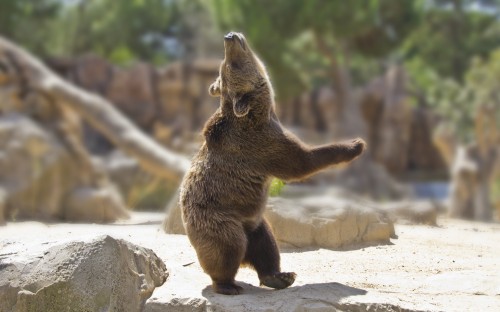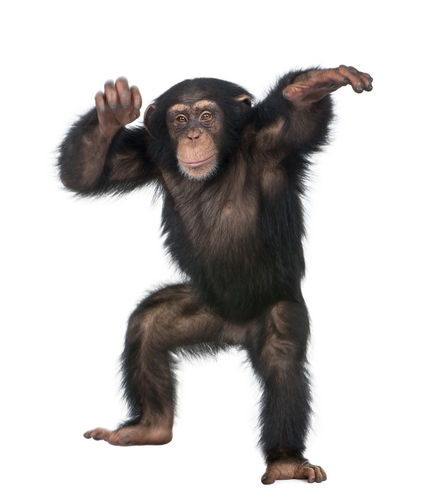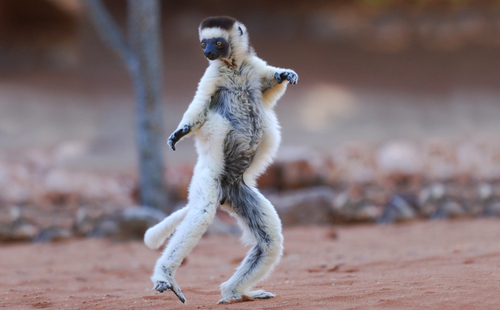 What do you do if you are trapped in a room with a chimpanzee, a macaque, and a sea lion? The answer, apparently, is pump the tunes and get the party started.
What do you do if you are trapped in a room with a chimpanzee, a macaque, and a sea lion? The answer, apparently, is pump the tunes and get the party started.
This week at the annual conference of the American Association for the Advancement of Science (basically the US version of the Royal Society) scientists discussed the ability of various animals to “synchronize with auditory beats.” In other words, to get their groove on. Some species, it seems, can recognize the beat of the rhythm of the night. Others reportedly can dance until the morning light. Unfortunately, ethologists are still divided as to whether they can forget about the worries on their minds.
The list of animals that can sway to the rhythm of love is short but growing. It includes macaques, bonobo chimps, an orphan cockatoo, a sea lion, and most shockingly, Peter Gabriel. Yes, these are adorable YouTube fodder but it turns out that this behavior might also open a window into a key set of mental processes.
I have claimed previously that my canary, Kevin (may he rest in peace), could sing along with various glam rock hits and crappy pop-chart-toppers from the 80s. In addition, I could swear that he was bobbing his head and chirping out a rhythm to accompany the tune. Peter Cook of the University of Santa Cruz says that just because it looks like an animal is moving to the beat doesn’t mean it’s true. In fact, it’s more likely that it’s us trying to attach meaning to the movement (a fact I am using liberally with my photo selection in this post).
 When you look carefully at it, the animal is either moving randomly or reacting to sounds and not anticipating a beat. To truly qualify as busting a move, an animal needs to be listening to the beat and then moving its body in synch with each beat. (Cook was not referring specifically to canaries or Kevin in particular and I stubbornly maintain that my bird was singing along thanks to evidence that canaries have been shown to have special brain systems associated with song learning.)
When you look carefully at it, the animal is either moving randomly or reacting to sounds and not anticipating a beat. To truly qualify as busting a move, an animal needs to be listening to the beat and then moving its body in synch with each beat. (Cook was not referring specifically to canaries or Kevin in particular and I stubbornly maintain that my bird was singing along thanks to evidence that canaries have been shown to have special brain systems associated with song learning.)
Edward Large of Florida Atlantic University says children are a great analogue for this.
“Much like the animals at Sea World, little children will move to music but they won’t synchronize to it to it. That’s the real issue,” says Large. “It’s about social interaction with another human being that encourages children to synchronizing to a beat.”
Babies don’t come out of the womb with rhythm and take a few years before they can shake their tiny booties on the dance floor (though many in my family sadly never really do). Large maintains that dancing in this sense is a very basic version of social coordination (either with another dancer or just to the invisible people playing the music inside the iPod).
Up until now, the study of dancing animals has been a sort of slow collection of examples. Chimps have been tapping out rhythms for decades to match either music or (more likely) a graduate student tapping on a drum outside the room. Their favorite speed tends to be around 280 beats per minute (about twice the speed of your average bumping dance club or the speed of a Barenaked Ladies song when they get going fast). Hugo Merchant of the Autonomous National University of Mexico, meanwhile is working with macaques, who struggle to learn how to tap along to a beat and prefer auditory beats rather than a visual ones (like a robotic arm or swinging pendulum or something). Even more surprisingly, Cook trained a sea lion to pick up on the rhythm of the Backstreet Boys, which is oddly the same band that inspired Snowball the cockatoo.
So what is it that scientists are tapping into, here? Is it just an oddity that makes for YouTube gold or are we seeing some fundamental brain process at work? If you look carefully at brain imaging, you can see certain electrical waves synchronize with a beat that a person or animal is hearing. But what’s the adaptive value? Why would evolution create this ability – either obvious or latent – in order to help an animal survive?
No one knows for sure beyond vague notions that it’s good to coordinate with other creatures. But this seems like a dynamic field and I would hazard that we may know the answer before too long. In the meantime, I might toss an idea out. Dimitri Christakis at the University of Washington for years has been looking at something he calls the internal metronome. It’s a sort of clock that he theorizes people develop to measure how fast stuff should happen in the world (and which he further postulates gets out of whack when children watch super fast cartoons too early in life).
Could it be that this internal metronome that paces out our lives is attached to our ability to tap along to “Ice Ice, Baby” when no one is watching? Could it be that the ability to follow a rhythm is a precursor to language or crucial for communication?
It’s possible. Or it’s possible that I just deeply underestimate the power of the Backstreet Boys.
Photo Credit: Shutterstock
After watching a Rolling Stones movie, my son exclaimed that Mick Jagger can’t even dance to the beat of his own band.
I find this topic extremely interesting in terms of SETI (the search for extraterrestrial intelligence). Given the plethora of creatures on Earth, if humans are the only ones who truly resonate to music, then we are clearly super, super unique. So, even if there is extraterrestrial life, even lots of it, for any of it to be as intelligent as humans (able to resonate to music!), it would have to be super, super unique and therefore extremely, extremely rare. Shades of Fermi’s Paradox…”Where are they?”
You can’t hear it, Herman, but that was the sound of my tiny little mind being blown.
Ummm… so where’s the picture of YOU dancing?
Who, me?
Probably don’t have a picture, but I do dance!
Am a long-time member of the Baltimore Folk Music Society. Also, used to habituate the local traditional Irish dance bars….even designed a t-shirt for one (The (late RIP) Gandy Dancer). Meanwhile, if they’re out there, they’d certainly have to be dancers. Also, they’d have their own Bachs, Beethovens and Gustav Mahlers! Note:Peabody Symphony
doing is 1st symphony (The Titan), Sat. eve.,8PM.
My father always said he was a gandy dancer. Was never sure whether or not to believe him. Do you have a pic of your T-shirt?
My wife often accuses me of being the missing link yet also claims I’m a wonderful dancer. Perhaps this explains that paradox.